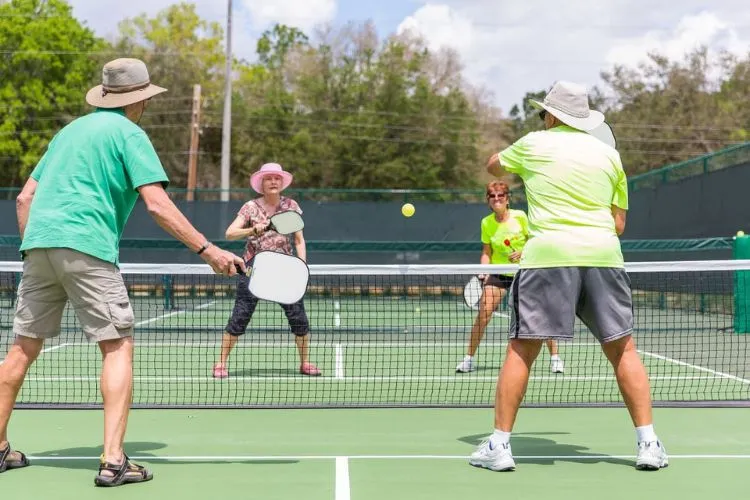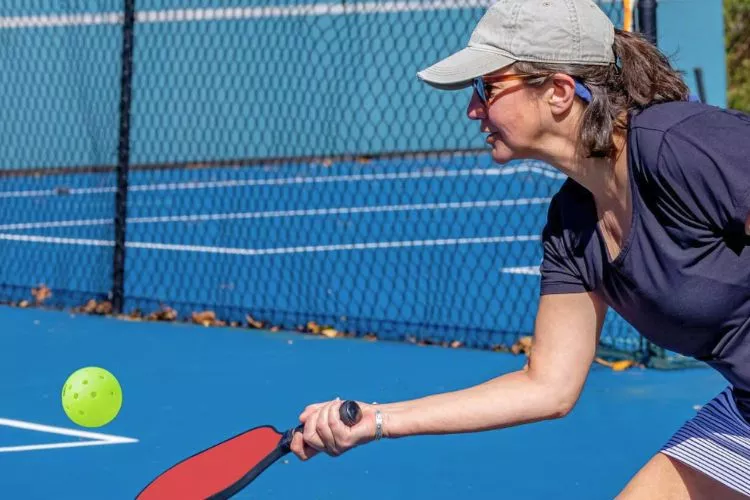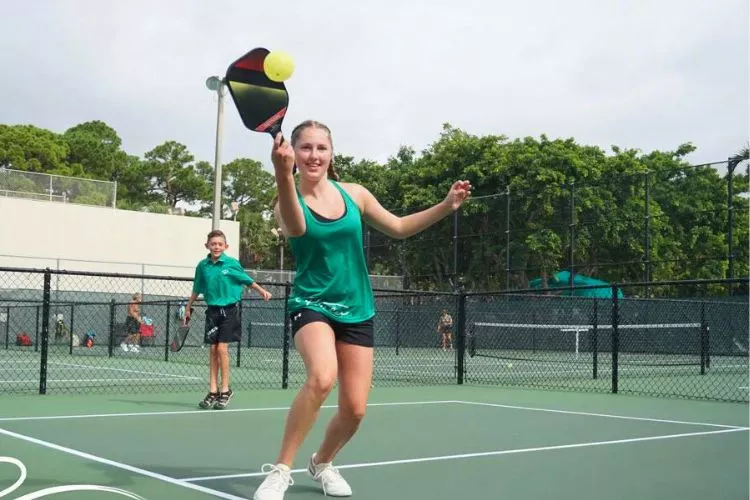A key strategy in pickleball is as essential as the racket you’re holding.
This article aims to dwell into the world of pickleball and uncover a key strategy that can take your gameplay from average to awe-inspiring. So let’s paddle together towards understanding this crucial aspect better. Let’s find out what is a key strategy in pickleball?

What is a key strategy in pickleball?
Pickleball can be an engaging and challenging game for beginners and professionals alike. Although there isn’t a single, definitive “best” approach, one key strategy that can enhance your game is known as the third shot drop.
Mastering this skill can make all the difference in outperforming your opponents and asserting control over the game. Here, we delve into the third shot drop and guide how to perfect this technique.
What is the Third Shot Drop?
In pickleball, players often take a serve and return, followed by a crucial third shot aimed at gaining control of the game. The third shot drop is a soft, precision shot executed to drop the ball into the opponent’s non-volley zone, also known as the kitchen. This strategy forces your opponents to hit the ball upward, allowing you to advance to the net and establish an offence.

Why is it Important?
The third shot drop serves multiple purposes in a pickleball match:
- Disrupting Opponent’s Strategy: A well-executed third shot drop interrupts your opponents’ rhythm and prevents them from volleying aggressively by keeping the ball low or forcing a soft shot from them.
- Gaining Control: By implementing the third shot drop, you allow yourself and your partner to move towards the non-volley zone (at the net), setting up a net presence and being ready for subsequent volleys.
- Creating Opportunities: Successfully placing a third shot drop gives you time to take a more dominant court position, ultimately creating opportunities to exploit your opponent’s weaknesses and win points.
How to Master the Third Shot Drop?
Improving your third shot drop strategy is all about practice and precision. Here are some helpful tips to perfect this technique:
- Work on your touch: As the third shot drop doesn’t require a full swing, focus on developing a gentle touch to the ball, ensuring a slow arc over the net. This can be achieved by loosening your grip and hitting with smooth control.
- Aim low and deep: Practice aiming your drop shot for the middle or corner of the kitchen. Low and deep shots are harder for opponents to attack or volley, allowing you to close in on the net.
- Focus on consistency: Practice the third shot drop, emphasizing proper form and repetition. This will help improve your consistency, which is crucial for maintaining pressure on your opponents.
- Analyze your opponents: To make the most of your third shot drop strategy, pay attention to your opponent’s movement, court position, and weak areas. Use these observations to tailor your approach and exploit potential vulnerabilities.
Incorporating the third-shot drop into your pickleball game enhances your playing prowess and gain a strategic edge over your competition. Remember that practice makes perfect, so be persistent in honing this vital skill to witness significant improvements in your performance.
Another Pickleball Strategy You May Find Useful
Pickleball also embraces an essential strategy known as the “Deep Serve and Return”. This management focuses extensively on serving and returning the ball deep into the opponent’s court to increase your chances of assuming control.
When the serve and the return are deep, it forces opponents further back into their court. This makes it harder for them to approach the net, provides you extra time to strategically prepare for the next shot, and disrupts their formation. A successful deep serve and return could provide an exceptional defensive advantage and establish an offensive opportunity.
Although this technique sounds simple, it requires consistent practice and accuracy. Tennis strategies are often applicable due to the similarity between the games, which reminds us of the essence of pickleball- a blend of ping-pong, tennis, and badminton.
Every single strategy in pickleball demands practice and understanding of the game to dominate the court. Therefore, learning and incorporating strategies like the third shot drop and deep serve and return shall give you an edge over your opponents and improve your overall gameplay.
What is 3rd shot strategy in pickleball?
The 3rd shot strategy, commonly referred to as the “third shot drop,” is a crucial strategic move in pickleball that concentrates on placing a soft, precise shot into the opponent’s non-volley zone (also known as the kitchen) after the serve and return.

This tactic aims to force the opponents to hit the ball upwards, thus allowing you to advance to the net and establish a powerful offense.
By successfully executing a third shot drop, you disrupt the opponents’ rhythm, gain control of the game, and create opportunities to exploit weaknesses and score points. Mastering this technique requires dedication to practice, consistency, and regular assessment of the opponent’s strengths and weaknesses.
What is a defensive strategy in pickleball?
A solid defensive strategy in pickleball revolves around controlling the pace and positioning of the gameplay. To efficiently defend against skilled opponents, consider these key elements:
- Deep serve and return: By sending the serve and return deep into the opponents’ court, you force them to move further back, making it harder for them to approach the net and providing you with time to strategically prepare for the next shot.
- Maintain proper court positioning: Ensuring you stay in the optimal position while moving synchronously with your partner allows you to cover the court effectively and minimize exposed gaps that the opponents can exploit.
- Soft handling of volleys: When opponents hit hard shots, it’s essential to soften your volleys. Use a loose grip and gentle shots to disrupt the opponents’ momentum and keep the ball in play, giving you time to recover and regroup.
- Lobs: A well-executed lob can neutralize an aggressive net game from the opponents. Use lobs when opponents are close to the net to send the ball over their heads and force them to retreat, allowing you to regain control.
Implementing a robust defensive strategy requires practice, anticipation, and adaptability to respond effectively to opponents’ offensive moves.
How do you become more aggressive in pickleball?
To become more aggressive in pickleball, focus on the following:
- Establishing a robust net presence: Develop an effective net game by quickly advancing to the non-volley zone and positioning yourself to place volleys and dinks that pressure the opponents.
- Attacking vulnerable shots: Exploit opponents’ weak shots (such as high dinks or slow volleys) by swiftly transitioning from dinks to aggressive volleys, aiming to hit the ball with pace and precision at their feet or towards their weak spots.
- Effective communication with your partner: Openly communicating allows you to maintain a solid formation, call out shots, and orchestrate strategic moves to dominate the court.
- Serve with purpose: A powerful, well-placed serve can put your opponents on the back foot right from the start, allowing you to attack their return.
- Body language and attitude: A confident, self-assured demeanor can psychologically impact your opponents, affecting their performance and reinforcing your aggressive approach.
Developing an aggressive game in pickleball requires practice, persistence, and a solid understanding of your strengths and weaknesses and your opponents’.
You May Also Find Useful: Shots Pickleball Beginner Should Know | How can I improve my pickleball fast?
Conclusion:
Utilizing key strategies, such as the third shot drop and deep serve and return, can open doors to a higher level of performance in pickleball. The integration of these strategies can disrupt opponents’ strategies, provide opportunities for aggressive and defensive plays, and ultimately elevate your game.
However, these techniques are not acquired overnight. Persistent practice, keen observation, and adaptation to opponents’ tactics are essential to mastering these strategies. With a patient and strategic approach, you can transform your pickleball game from ordinary to extraordinary and enjoy this captivating sport even more.

Pickleball’s more than a game to me—it’s a passion. I write, sharing its highs and lows, the thrills and the lessons. Some tales might draw you to the court, while others give a hint of the game’s magic. So, curious about my journey? Ready to dive deep into the world of pickleball with me? Let’s go.
